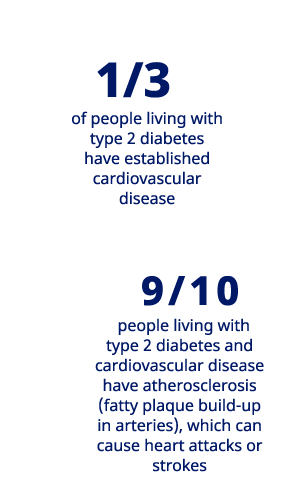
Are you aware of cardiovascular risk?
People with type 2 diabetes are 2-4 times more likely to have a heart
attack or stroke compared to someone living without diabetes. 12,13
Learn how you can reduce the risk.
Digital technology is advancing in almost every aspect of life, and
managing diabetes is no exception. The COVID-19 pandemic triggered a
dramatic advance in digital health and health technologies, largely
because of social distancing requirements.1 Diabetes is
well-suited to digital monitoring, apps and online tools, and diabetes
technology is developing at an extremely rapid pace.2 With
support from your doctor and diabetes educator, this new technology is
not difficult to understand. It could make it easier for you to manage
your diabetes, helping you feel more in control.
The
rapid advances in digital health have given many people new and
different ways to help them manage their diabetes.3 With
digital monitoring devices and diabetes apps on smartphones, you can
access more information than ever before, which can give you more
support in everyday life.4 Digital health and health
technologies are going to play an increasingly important role in
diabetes management.4
So, with these new
advancements, what choices do you have, and how can this new
technology help you control your diabetes?
People with type 2 diabetes are 2-4 times more likely to have a heart
attack or stroke compared to someone living without diabetes. 12,13
Learn how you can reduce the risk.
Traditionally, self-monitoring blood glucose (SMBG) devices have been used to test blood sugar at home using glucose test strips to take a snapshot of your blood sugar levels at a single point in time.5 But you need to prick your finger and physically take several readings throughout the day.5
More recently, devices have been developed that allow real-time 24-hour monitoring of your blood sugar levels, called continuous glucose monitors (CGM).2,6 A CGM device takes your ‘interstitial’ glucose measurements using a small sensor attached to your body through a tiny wire just under the skin.
Interstitial glucose sounds complicated but all it means is that the monitor measures the sugar level in the fluid under your skin rather than directly from your blood.2 The sensor sends this information to a reader which then shows the numbers and stores all the data.2 CGMs allow you to quickly check your sugar levels without having to do finger pricks, as they track your glucose levels continuously, around the clock. This gives you a more accurate understanding of your day-to-day fluctuations.6
The data from a CGM is sent to your smartphone app or reader, providing useful insights to help you increase your understanding of your daily sugar patterns and manage your diabetes better. CGMs can show you lots of different useful measures, including:6
Download this free CGM Cheat Sheet which gives you the basics about starting with a CGM
People with type 2 diabetes are 2-4 times more likely to have a heart
attack or stroke compared to someone living without diabetes.
Learn how you can reduce the risk.
Diabetes technology lets Mary see her diabetes blood sugar numbers through the day
Lasse’s CGM has made it much easier for him to live with diabetes
It is easy to ‘turn off’ when data is mentioned. But getting more
information about your glucose levels could help you manage your
diabetes better. The ability to check your sugar levels easily and
quickly can build a sense of control.7 CGMs have alarms
that can help you avoid both low sugar levels (hypoglycaemia) and high
sugar levels (hyperglycaemia). Avoiding lows and highs can reduce your
risk of complications in the future.6,7 People using
digital health solutions, such as CGMs, have said that these devices
have helped them adopt a healthier lifestyle.8
Would a digital device motivate you to go for a walk
or swap a piece of cake for a healthier option?
Everyone’s diabetes is different, and CGMs allow a more
flexible and personalised approach to your diabetes.6
Continuous glucose monitoring can also help you to have better
conversations with your healthcare professional.6 The
measurements and insights from your CGM monitor are automatically made
into an easy-to-read report which you can discuss and
then use to make decisions together about managing your diabetes.6
Time in Range (TiR) is one CGM measure that can help you
keep track of and manage your glucose variations. Time in Range uses
the numbers from your CGM to show how much time you spend in your
target blood sugar range. For most people, this is between 70 and 180
mg/dl (3.9–10 mmol/l).6 During the global pandemic, many
people successfully used digital
health and TiR to monitor their glucose levels, and it has been
suggested that the new measure could help give people more control
over their diabetes.9,10
Experts recommend that if you have type 1 or type 2 diabetes, most people should spend at least 17 hours (70%) of their day within this range.6 (Check with your doctor for your personal target).
Have a look
at this article to read more about the new diabetes measurement
Time in Range.
CGMs and Time in Range (TiR) are just some
examples of diabetes digital health that can help you better manage
your diabetes.6 There are other innovations on the
horizon.4 By using diabetes monitoring devices like CGMs
that connect to a smartphone or tablet, you can stay on track hour by
hour with your sugar levels.6 By using Time in Range (TiR),
with the support of your healthcare professional, you can make
treatment decisions and personalised choices about your diet and
lifestyle that work for you. And you don’t need to wait until your
next appointment to see how you’re doing; with a CGM you can monitor
your diabetes every day.7 A
quick look at this article will help you understand more about
how digital health can help you manage your diabetes.
This free CGM Cheat Sheet gives you the basics about starting with a
CGM and TiR
HQ22DI00220

